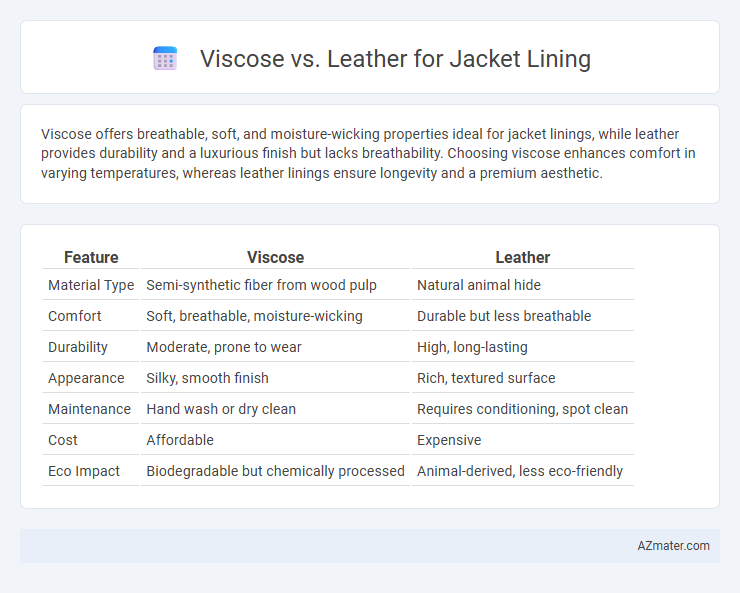Viscose offers breathable, soft, and moisture-wicking properties ideal for jacket linings, while leather provides durability and a luxurious finish but lacks breathability. Choosing viscose enhances comfort in varying temperatures, whereas leather linings ensure longevity and a premium aesthetic.
Table of Comparison
| Feature | Viscose | Leather |
|---|---|---|
| Material Type | Semi-synthetic fiber from wood pulp | Natural animal hide |
| Comfort | Soft, breathable, moisture-wicking | Durable but less breathable |
| Durability | Moderate, prone to wear | High, long-lasting |
| Appearance | Silky, smooth finish | Rich, textured surface |
| Maintenance | Hand wash or dry clean | Requires conditioning, spot clean |
| Cost | Affordable | Expensive |
| Eco Impact | Biodegradable but chemically processed | Animal-derived, less eco-friendly |
Introduction to Jacket Lining Materials
Viscose and leather are popular materials used for jacket linings, each offering unique qualities that impact comfort and durability. Viscose, a semi-synthetic fiber derived from cellulose, provides a smooth, breathable, and lightweight lining suitable for moderate climates. Leather linings contribute to warmth and a luxurious feel, with high resistance to wear and tear, making them ideal for premium or cold-weather jackets.
What is Viscose?
Viscose is a semi-synthetic fiber derived from cellulose, often sourced from wood pulp, prized for its silky texture and breathability, making it a popular choice for jacket linings. Compared to leather, viscose offers enhanced moisture absorption and a lightweight feel, ensuring comfort during prolonged wear. Its smooth surface reduces friction against the skin, providing a sleek, luxurious inner jacket finish without the stiffness associated with leather.
What is Leather Lining?
Leather lining in jackets refers to a thin, supple layer of animal hide used inside garments to provide durability, insulation, and a luxurious feel. It offers excellent breathability and moisture-wicking properties, making it ideal for maintaining comfort in various climates. Compared to viscose, leather lining is more robust and long-lasting but requires more care to prevent damage from moisture and wear.
Comfort Comparison: Viscose vs Leather
Viscose offers superior breathability and moisture-wicking properties, making it more comfortable for jacket lining in warm or humid conditions compared to leather. Leather linings tend to retain heat and can feel stiff against the skin, reducing overall comfort during extended wear. Choosing viscose enhances temperature regulation and skin softness, ideal for those prioritizing comfort in jacket liners.
Breathability and Moisture Management
Viscose lining offers superior breathability compared to leather, allowing better air circulation that keeps the wearer cooler and reduces sweat buildup. Leather linings, while durable and luxurious, tend to trap heat and moisture, which can result in discomfort during prolonged wear. Viscose excels in moisture management by wicking away sweat efficiently, making it ideal for jackets used in warmer or active environments.
Durability and Longevity
Viscose jacket linings offer a smooth, breathable fabric that is lightweight but tends to wear out faster with frequent use due to lower abrasion resistance. Leather linings provide exceptional durability and longevity, resisting tears and wear much better over time, making them ideal for heavy-duty or long-lasting jackets. Choosing leather over viscose for lining ensures prolonged jacket life, especially in harsh conditions or frequent wear scenarios.
Style and Aesthetic Appeal
Viscose linings offer a smooth, lustrous finish that enhances the luxury feel and drape of jackets, making them ideal for stylish, refined aesthetics. Leather linings provide a rugged, distinctive texture that adds boldness and character to jackets, appealing to edgy and fashion-forward tastes. The choice between viscose and leather lining ultimately influences the jacket's overall visual impression and style statement.
Care and Maintenance Requirements
Viscose jacket linings require gentle care with hand washing or dry cleaning to preserve fabric softness and prevent shrinkage, while leather linings demand specialized leather cleaners and conditioners to maintain suppleness and prevent cracking. Avoiding excessive moisture and direct heat exposure is crucial for both materials to extend the jacket's lifespan. Proper storage in breathable garment bags helps prevent mold in viscose and drying out or stiffening in leather linings.
Environmental and Ethical Considerations
Viscose jacket linings, derived from cellulose fibers like wood pulp, offer a biodegradable and renewable option but often involve chemically intensive processes that raise environmental concerns. Leather linings, sourced from animal hides, pose significant ethical challenges due to animal welfare issues and high environmental impacts from livestock farming, including greenhouse gas emissions and water usage. Choosing viscose supports renewable resource use, while leather's sustainability heavily depends on sourcing practices and animal treatment standards.
Which Lining is Best for You?
Viscose lining offers breathability and moisture-wicking properties, making it ideal for those seeking comfort in various climates, while leather lining provides durability and a luxurious feel, perfect for cooler weather and premium jackets. Consider viscose if you prioritize lightweight softness and temperature regulation, whereas leather suits individuals looking for a sturdy, long-lasting lining with added warmth. Your choice depends on climate, comfort preferences, and the jacket's intended use, balancing breathability against insulation and luxury.

Infographic: Viscose vs Leather for Jacket Lining
 azmater.com
azmater.com